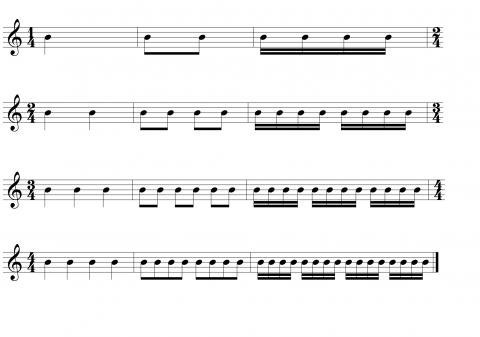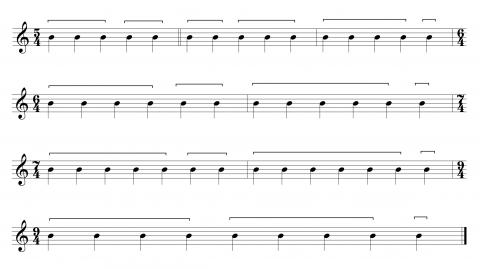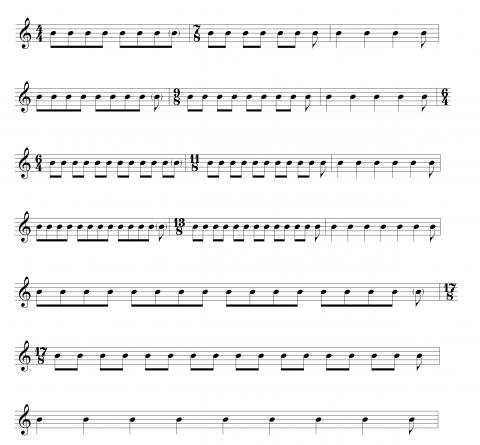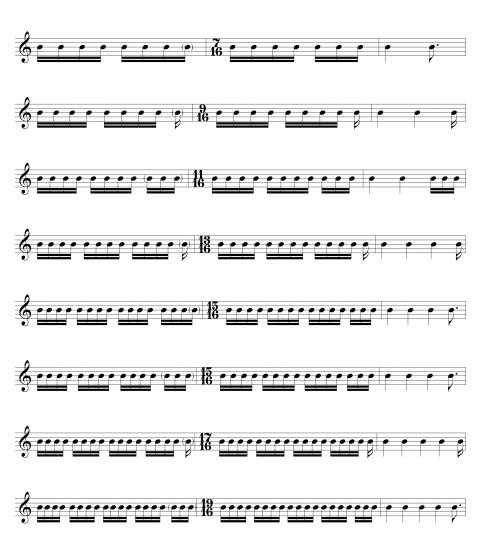Working with the Math
For musicians, odd-time signatures can be intimidating, mainly because they are often misunderstood. Despite their comfort level with the more common “even” times, many players are scared by the math underneath the odd times.
But in fact, how many musicians have a deep understanding of the math underlying the most familiar even times? To understand odd times, we should first examine subdivisions in even times. Then we can find ways to relate any odd-time signature to an even one simply by working with the math.
The first step is to identify the number of subdivisions in a given time signature (see the time signature chart below). Reviewing the subdivisions will help you understand the mathematics. From there we can move on to applying subdivisions on the chart to odd time signatures.
Approaching Odd Times
Let’s start with time signatures that contain the quarter-note subdivision. Example one shows four of the most common odd times with a quarter-note pulse, and a couple of ways to think about an odd time signature. The bar of 9/4 is an exception, and I’ve presented just one approach that, I believe, is easiest to understand.
If a musician just learns to play a time signature one way, it can get boring. I always let the melody dictate how I should feel the odd-time signature. Be flexible and learn to feel any given time signature in a variety of ways. Example one illustrates different ways to group the pulses in a variety of odd time signatures. We can think of the subdivisions in a bar of 5/4 and 7/4 in a few different ways. One way to create a good feel and groove in 7/4 is to think of it as a bar of 6/4 with an extra quarter note added: 6/4 plus 1/4.
Eighth-Note Subdivisions
In example two, I’ve used familiar time signatures as the basis for subdivisions that result in odd times. It’s very important to try to get these time signatures to groove as if the time were 4/4. We can subtract an eighth note to make a bar of 7/8 from a bar of 4/4 or 11/8 from a bar of 6/4. We can add an eighth note to a bar of 4/4 to create a bar of 9/8 or to make 13/8 from a bar of 6/4. This approach can make the oddest of time signatures feel more natural.
To build a more complex time signature such as 17/8, we can start by figuring out the simplest mathematical combinations using even time signatures. The easiest way to think of 17/8 is 4/4 plus 4/4 plus 1/8 (see example two, fifth system). Much more could be said about compound meters with an 8 as the denominator and where the beat is divided into three rather than two. But this topic exceeds the scope of this lesson.
Sixteenth Notes Are Scarier
Most people find time signatures based on sixteenth-note subdivisions to be the scariest. Just as with the time signatures above where we looked at eight-note subdivisions, our goal here is to make these time signatures feel as close to familiar time signatures as possible. We will still use addition or subtraction, but instead of using an eighth note or one value, we will use two values: 1/16 and 3/16. When taking the subtractive approach, many musicians find it easier to subtract one sixteenth note rather than three sixteenth notes. But as you work through the process of adding a sixteenth note, you will find that both values work well.
To create 7/16, look at it as a bar of 2/4 with one sixteenth note subtracted. Look at the various groupings shown in example three. By using the method of adding or subtracting a sixteenth note, you can devise other complex time signatures.
Implying Odd Times Over Even Times
Since most Western music is in 4/4, it is important to know how to play odd times in musically appealing ways. It is great to be able to play in crazy time signatures, but if a listener can’t make sense of what is happening, there’s little point to such complexity. Since most musicians play a lot of things in 4/4, let’s try to imply an odd-time feel in that time signature.
Let’s begin with the eighth-note subdivisions. A bar of 4/4 has eight eighth notes, so we could make groupings that imply 5/8 plus 3/8. In example four, see where the implied accents fall in relation to the underlying quarter-note pulse. Once you can comfortably feel these rhythmic groupings superimposed over the quarter-note pulse, you will be able to effortlessly imply odd-time signatures even while playing the most familiar grooves.

Time Signature Chart

Ex. 1

Ex. 2

Ex. 3

Ex. 4




